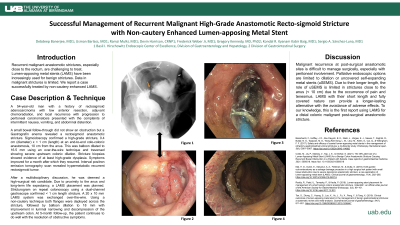Back


Poster Session C - Monday Afternoon
Category: Endoscopy Video Forum
C0194 - Successful Management of Recurrent Malignant High-Grade Anastomotic Recto-Sigmoid Stricture With Non-Cautery Enhanced Lumen-Apposing Metal Stent
Monday, October 24, 2022
3:00 PM – 5:00 PM ET
Location: Crown Ballroom

Has Audio

Debdeep Banerjee, MD
University of Alabama at Birmingham School of Medicine
Birmingham, AL
Presenting Author(s)
Debdeep Banerjee, MD1, Usman Barlass, MD2, Ramzi Mulki, MD2, Devin Harrison, CRNP3, Frederick Weber, MD1, Gregory Kennedy, MD1, Kondal R. Kyanam Kabir Baig, MD2, Sergio A. Sánchez-Luna, MD3
1University of Alabama at Birmingham School of Medicine, Birmingham, AL; 2University of Alabama at Birmingham, Birmingham, AL; 3University of Alabama Birmingham, Birmingham, AL
Introduction: Recurrent malignant anastomotic strictures, especially close to the rectum, are challenging to treat. Lumen-apposing metal stents (LAMS) have been increasingly used for benign strictures. Data in malignant strictures is limited. We report a case successfully treated by non-cautery enhanced LAMS.
Case Description/Methods: A 54-year-old man with a history of rectosigmoid adenocarcinoma post low anterior resection, adjuvant chemoradiation, and local recurrence with progression to peritoneal carcinomatosis presented with the complaints of intermittent nausea, vomiting, and abdominal distention.
A small bowel follow-through did not show an obstruction but a Gastrograffin enema revealed a rectosigmoid anastomotic stricture. Sigmoidoscopy confirmed a high-grade stricture, 0.4 cm (diameter) x < 1 cm (length) at an end-to-end colo-colonic anastomosis, 10 cm from the anus. This was balloon dilated to 16.5 mm using an over-the-wire technique and traversed showing severe upstream colonic dilation. Stricture biopsies showed evidence of at least high-grade dysplasia. Symptoms improved for a month after which they recurred. Interval positron emission tomography scan revealed hypermetabolic recurrent rectosigmoid tumor.
After a multidisciplinary discussion, he was deemed a high-surgical risk candidate. Due to proximity to the anus and long-term life expectancy, a LAMS placement was planned. Stricturogram on repeat colonoscopy using a dual-channel gastroscope confirmed < 1 cm length stricture. A 20 x 10 mm LAMS system was exchanged over-the-wire. Using a non-cautery technique both flanges were deployed across the stricture, followed by balloon dilation to 18 mm with improvement in luminal narrowing and decompression of the upstream colon. At 5-month follow-up, the patient continues to do well with the resolution of obstructive symptoms.
Discussion: Malignant recurrence at post-surgical anastomotic sites is difficult to manage surgically, especially with peritoneal involvement. Palliative endoscopic options are limited to dilation or uncovered self-expanding metal stents (uSEMS). Due to their longer length, the role of uSEMS is limited in strictures close to the anus (< 10 cm) due to the occurrence of pain and tenesmus. LAMS with their short length and fully covered nature can provide a longer-lasting alternative with the avoidance of adverse effects. To our knowledge, this is the first report using LAMS for a distal colonic malignant post-surgical anastomotic stricture.
Disclosures:
Debdeep Banerjee, MD1, Usman Barlass, MD2, Ramzi Mulki, MD2, Devin Harrison, CRNP3, Frederick Weber, MD1, Gregory Kennedy, MD1, Kondal R. Kyanam Kabir Baig, MD2, Sergio A. Sánchez-Luna, MD3. C0194 - Successful Management of Recurrent Malignant High-Grade Anastomotic Recto-Sigmoid Stricture With Non-Cautery Enhanced Lumen-Apposing Metal Stent, ACG 2022 Annual Scientific Meeting Abstracts. Charlotte, NC: American College of Gastroenterology.
1University of Alabama at Birmingham School of Medicine, Birmingham, AL; 2University of Alabama at Birmingham, Birmingham, AL; 3University of Alabama Birmingham, Birmingham, AL
Introduction: Recurrent malignant anastomotic strictures, especially close to the rectum, are challenging to treat. Lumen-apposing metal stents (LAMS) have been increasingly used for benign strictures. Data in malignant strictures is limited. We report a case successfully treated by non-cautery enhanced LAMS.
Case Description/Methods: A 54-year-old man with a history of rectosigmoid adenocarcinoma post low anterior resection, adjuvant chemoradiation, and local recurrence with progression to peritoneal carcinomatosis presented with the complaints of intermittent nausea, vomiting, and abdominal distention.
A small bowel follow-through did not show an obstruction but a Gastrograffin enema revealed a rectosigmoid anastomotic stricture. Sigmoidoscopy confirmed a high-grade stricture, 0.4 cm (diameter) x < 1 cm (length) at an end-to-end colo-colonic anastomosis, 10 cm from the anus. This was balloon dilated to 16.5 mm using an over-the-wire technique and traversed showing severe upstream colonic dilation. Stricture biopsies showed evidence of at least high-grade dysplasia. Symptoms improved for a month after which they recurred. Interval positron emission tomography scan revealed hypermetabolic recurrent rectosigmoid tumor.
After a multidisciplinary discussion, he was deemed a high-surgical risk candidate. Due to proximity to the anus and long-term life expectancy, a LAMS placement was planned. Stricturogram on repeat colonoscopy using a dual-channel gastroscope confirmed < 1 cm length stricture. A 20 x 10 mm LAMS system was exchanged over-the-wire. Using a non-cautery technique both flanges were deployed across the stricture, followed by balloon dilation to 18 mm with improvement in luminal narrowing and decompression of the upstream colon. At 5-month follow-up, the patient continues to do well with the resolution of obstructive symptoms.
Discussion: Malignant recurrence at post-surgical anastomotic sites is difficult to manage surgically, especially with peritoneal involvement. Palliative endoscopic options are limited to dilation or uncovered self-expanding metal stents (uSEMS). Due to their longer length, the role of uSEMS is limited in strictures close to the anus (< 10 cm) due to the occurrence of pain and tenesmus. LAMS with their short length and fully covered nature can provide a longer-lasting alternative with the avoidance of adverse effects. To our knowledge, this is the first report using LAMS for a distal colonic malignant post-surgical anastomotic stricture.
Disclosures:
Debdeep Banerjee indicated no relevant financial relationships.
Usman Barlass indicated no relevant financial relationships.
Ramzi Mulki indicated no relevant financial relationships.
Devin Harrison indicated no relevant financial relationships.
Frederick Weber indicated no relevant financial relationships.
Gregory Kennedy indicated no relevant financial relationships.
Kondal Kyanam Kabir Baig: Ambu – Consultant. Ambu – Grant/Research Support. Olympus – Grant/Research Support.
Sergio Sánchez-Luna indicated no relevant financial relationships.
Debdeep Banerjee, MD1, Usman Barlass, MD2, Ramzi Mulki, MD2, Devin Harrison, CRNP3, Frederick Weber, MD1, Gregory Kennedy, MD1, Kondal R. Kyanam Kabir Baig, MD2, Sergio A. Sánchez-Luna, MD3. C0194 - Successful Management of Recurrent Malignant High-Grade Anastomotic Recto-Sigmoid Stricture With Non-Cautery Enhanced Lumen-Apposing Metal Stent, ACG 2022 Annual Scientific Meeting Abstracts. Charlotte, NC: American College of Gastroenterology.
